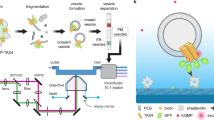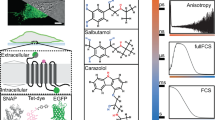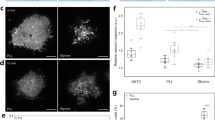Abstract
The contraction of cardiac myocytes is initiated by ligand binding to adrenergic receptors1,2 contained in nanoscale multiprotein complexes called signalosomes3. The composition and number of functional signalosomes within cardiac myocytes defines the molecular basis of the response to adrenergic stimuli3,4,5,6. For the first time, we demonstrated the ability of near-field scanning optical microscopy to visualize β-adrenergic receptors at the nanoscale in situ. On H9C2 cells, mouse neonatal and mouse embryonic cardiac myocytes, we showed that functional receptors are organized into multiprotein domains of ∼140 nm average diameter. Colocalization experiments in primary cells at the nanometer scale showed that 15–20% of receptors were preassociated in caveolae. These nanoscale complexes were sufficient to effect changes in ligand-induced contraction rate without the requirement for substantial changes in receptor distribution in the cellular membrane. Using fluorescence intensities associated with these nanodomains, we estimated the receptor density within the observed nanometer features and established a lower limit for the number of receptors in the signalosome.
This is a preview of subscription content, access via your institution
Access options
Subscribe to this journal
Receive 12 print issues and online access
$259.00 per year
only $21.58 per issue
Buy this article
- Purchase on Springer Link
- Instant access to full article PDF
Prices may be subject to local taxes which are calculated during checkout



Similar content being viewed by others
References
Hall, R.A. & Lefkowitz, R.J. Regulation of G protein-coupled receptor signaling by scaffold proteins. Circ. Res. 91, 672–680 (2002).
Rockman, H.A., Koch, W.J. & Lefkowitz, R.J. Seven-transmembrane-spanning receptors and heart function. Nature 415, 206–212 (2002).
Razani, B., Woodman, S.E. & Lisanti, M.P. Caveolae: from cell biology to animal physiology. Pharmacol. Rev. 54, 431–467 (2002).
Luttrell, L.M. et al. β-arrestin-dependent formation of β(2) adrenergic receptor Src protein kinase complexes. Science 283, 655–661 (1999).
Rybin, V.O., Xu, X.H., Lisanti, M.P. & Steinberg, S.F. Differential targeting of β-adrenergic receptor subtypes and adenylyl cyclase to cardiomyocyte caveolae—a mechanism to functionally regulate the cAMP signaling pathway. J. Biol. Chem. 275, 41447–41457 (2000).
Lisanti, M.P., Scherer, P.E., Tang, Z. & Sargiacomo, M. Caveolae, caveolin and caveolin-rich membrane domains: a signalling hypothesis. Trends Cell Biol. 4, 231–235 (1994).
Davare, M.A. et al. A β(2) adrenergic receptor signaling complex assembled with the Ca2+ channel Ca(v)1.2. Science 293, 98–101 (2001).
Bouvier, M. Oligomerization of G-protein-coupled transmitter receptors. Nat. Rev. Neurosci. 2, 274–286 (2001).
Hebert, T.E. & Bouvier, M. Structural and functional aspects of G protein-coupled receptor oligomerization. Biochem. Cell Biol. 76, 1–11 (1998).
Bouvier, M. et al. Removal of phosphorylation sites from the β-2-adrenergic receptor delays onset of agonist-promoted desensitization. Nature 333, 370–373 (1988).
Fotiadis, D. et al. Atomic-force microscopy: rhodopsin dimers in native disc membranes. Nature 421, 127–128 (2003).
Lewis, A. et al. Near-field optics: from subwavelength illumination to nanometric shadowing. Nat. Biotechnol. 21, 1378–1386 (2003).
Koopman, M. et al. Near-field scanning optical microscopy in liquid for high resolution single molecule detection on dendritic cells. FEBS Lett. 573, 6–10 (2004).
Ianoul, A. et al. Near-field scanning fluorescence microscopy study of ion channel clusters in cardiac myocyte membranes. Biophys. J. 87, 3525–3535 (2004).
Hescheler, J. et al. Morphological, biochemical, and electrophysiological characterization of a clonal cell (H9C2) line from rat-heart. Circ. Res. 69, 1476–1486 (1991).
Salahpour, A. et al. Homodimerization of the β-2-adrenergic receptor as a prerequisite for cell surface targeting. J. Biol. Chem. 279, 33390–33397 (2004).
Flesch, M. et al. Differential effects of carvedilol and metoprolol on isoprenaline-induced changes in β-adrenoceptor density and systolic function in rat cardiac myocytes. Cardiovasc. Res. 49, 371–380 (2001).
Hegener, O. et al. Dynamics of β (2)-adrenergic receptor - Ligand complexes on living cells. Biochemistry 43, 6190–6199 (2004).
Angers, S. et al. Detection of β (2)-adrenergic receptor dimerization in living cells using bioluminescence resonance energy transfer (BRET). Proc. Natl. Acad. Sci. USA 97, 3684–3689 (2000).
Steinberg, S.F. The molecular basis for distinct β-adrenergic receptor subtype actions in cardiomyocytes. Circ. Res. 85, 1101–1111 (1999).
Xiang, Y., Rybin, V.O., Steinberg, S.F. & Kobilka, B. Caveolar localization dictates physiologic signaling of β (2)-adrenoceptors in neonatal cardiac myocytes. J. Biol. Chem. 277, 34280–34286 (2002).
Rohrer, D.K., Schauble, E.H., Desai, K.H., Kobilka, B.K. & Bernstein, D. Alterations in dynamic heart rate control in the beta(1)-adrenergic receptor knockout mouse. Am. J. Physiol. Heart Circ. Physiol. 43, H1184–H1193 (1998).
Chruscinski, A.J. et al. Targeted disruption of the β-2 adrenergic receptor gene. J. Biol. Chem. 274, 16694–16700 (1999).
Portbury, A.L. et al. Catecholamines act via a β-adrenergic receptor to maintain fetal heart rate and survival. Am. J. Physiol. Heart Circ. Physiol. 284, H2069–H2077 (2003).
Ostrom, R.S. et al. Receptor number and caveolar co-localization determine receptor coupling efficiency to adenylyl cyclase. J. Biol. Chem. 276, 42063–42069 (2001).
Manders, E.M.M., Verbeek, F.J. & Aten, J.A. Measurement of colocalization of objects in dual color confocal images. J. Microscopy-Oxford 169, 375–382 (1993).
Burgos, P. et al. Near-field scanning optical microscopy probes: a comparison of pulled and double-etched bent NSOM probes for fluorescence imaging of biological samples. J. Microscopy-Oxford 211, 37–47 (2003).
Rizzuto, R., Brini, M., Murgia, M. & Pozzan, T. Microdomains With High Ca2+ Close to Ip(3)-Sensitive Channels That Are Sensed By Neighboring Mitochondria. Science 262, 744–747 (1993).
Zaccolo, M. & Pozzan, T. Discrete microdomains with high concentration of cAMP in stimulated rat neonatal cardiac myocytes. Science 295, 1711–1715 (2002).
Ghanouni, P., Steenhuis, J.J., Farrens, D.L. & Kobilka, B.K. Agonist-induced conformational changes in the G-protein-coupling domain of the β(2) adrenergic receptor. Proc. Natl. Acad. Sci. USA 98, 5997–6002 (2001).
Acknowledgements
L.J.J. and J.P.P. thank the Genomics and Health Initiative of the National Research Council Canada for partial financial support for this research. We thank R. Trembley for assistance in primary cell isolation, Z. Lu for NSOM imaging support, D. Moffatt for assistance with cluster analysis software, and R. Taylor and N.K. Goto (University of Ottawa) for useful discussions.
Author information
Authors and Affiliations
Corresponding authors
Ethics declarations
Competing interests
The authors declare no competing financial interests.
Supplementary information
Supplementary Fig. 1
Examples of analyses of numbers of secondary antibodies (Ab) per cluster based on fluorescence intensities and an antibody dilution calibration. (PDF 65 kb)
Supplementary Fig. 2
Fluorescence microscopy images comparing wet vs. dry H9C2 cardiac myocytes stained with DAPI and with an anti-β2AR Ab. (PDF 31 kb)
Supplementary Fig. 3
Fluorescence microscopy images of β2AR-GFP fusion proteins overexpressed in HEK293 cells. (PDF 58 kb)
Supplementary Fig. 4
Analyses of two sets of colocalization data from NSOM imaging of neonatal mouse cardiac myocytes using Image J software with the Colocalization Threshold plug-in. (PDF 249 kb)
Supplementary Fig. 5
An example of cluster analysis performed for NSOM images. (PDF 183 kb)
Supplementary Table 1
Cluster densities for individual images for β2AR and β1AR in H9C2 cells and for β2AR in neonatal cardiac myocytes. (PDF 15 kb)
Rights and permissions
About this article
Cite this article
Ianoul, A., Grant, D., Rouleau, Y. et al. Imaging nanometer domains of β-adrenergic receptor complexes on the surface of cardiac myocytes. Nat Chem Biol 1, 196–202 (2005). https://doi.org/10.1038/nchembio726
Received:
Accepted:
Published:
Issue Date:
DOI: https://doi.org/10.1038/nchembio726
This article is cited by
-
Catestatin reverses the hypertrophic effects of norepinephrine in H9c2 cardiac myoblasts by modulating the adrenergic signaling
Molecular and Cellular Biochemistry (2020)
-
GPCR: G protein complexes—the fundamental signaling assembly
Amino Acids (2013)
-
Both Ca2+ and Zn2+ are essential for S100A12 protein oligomerization and function
BMC Biochemistry (2009)



